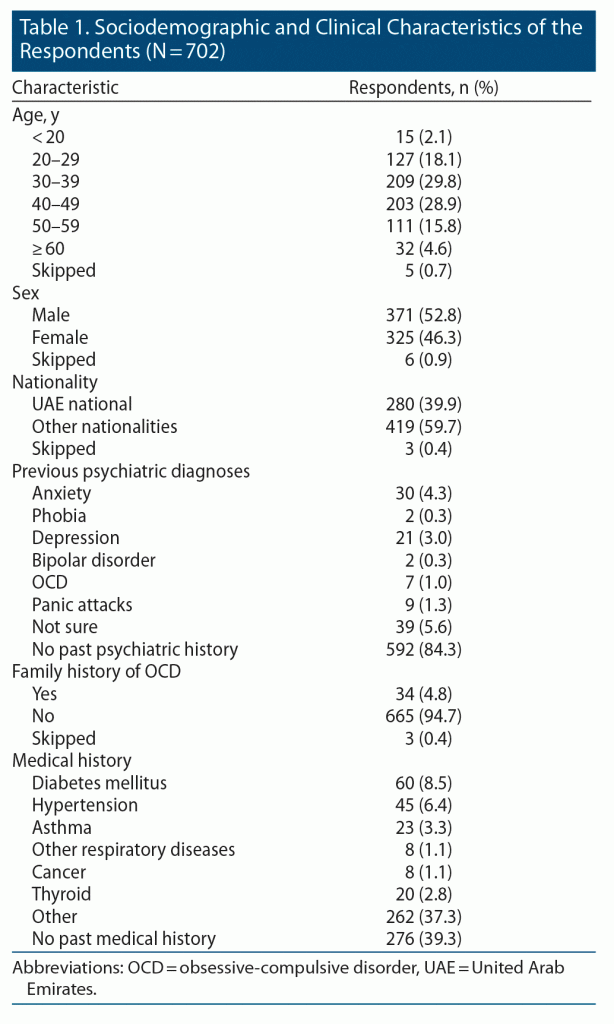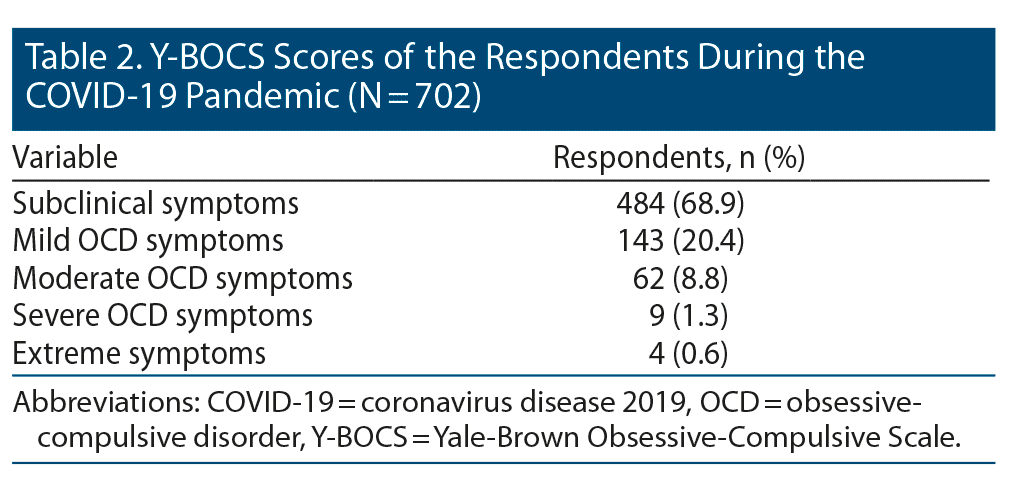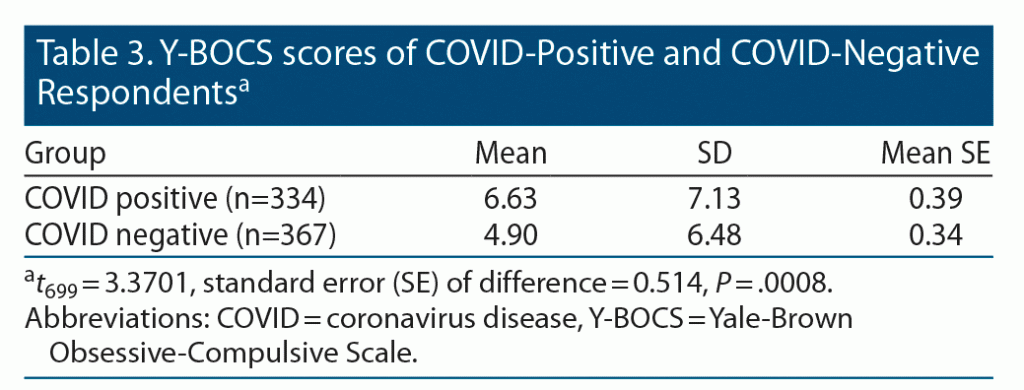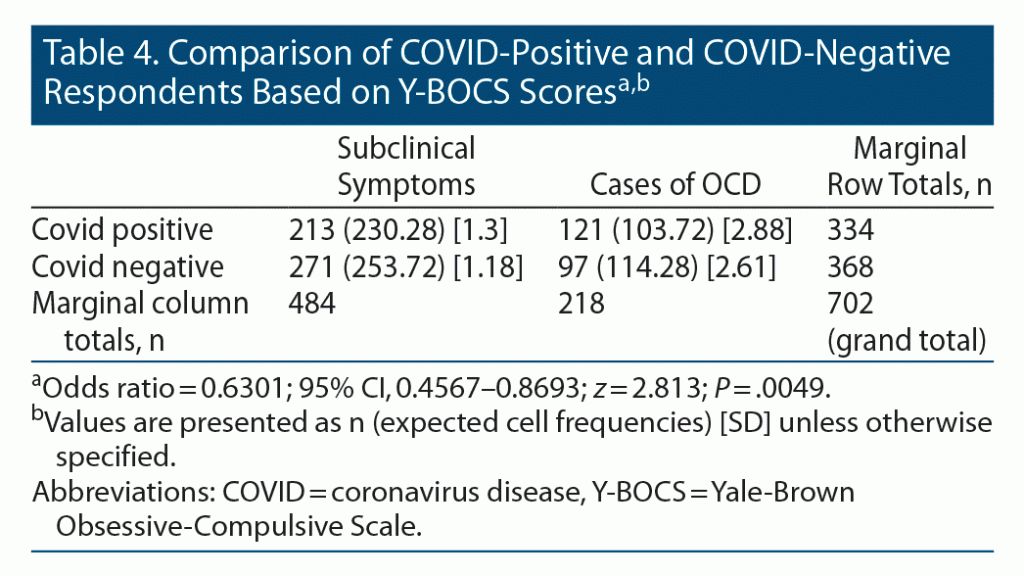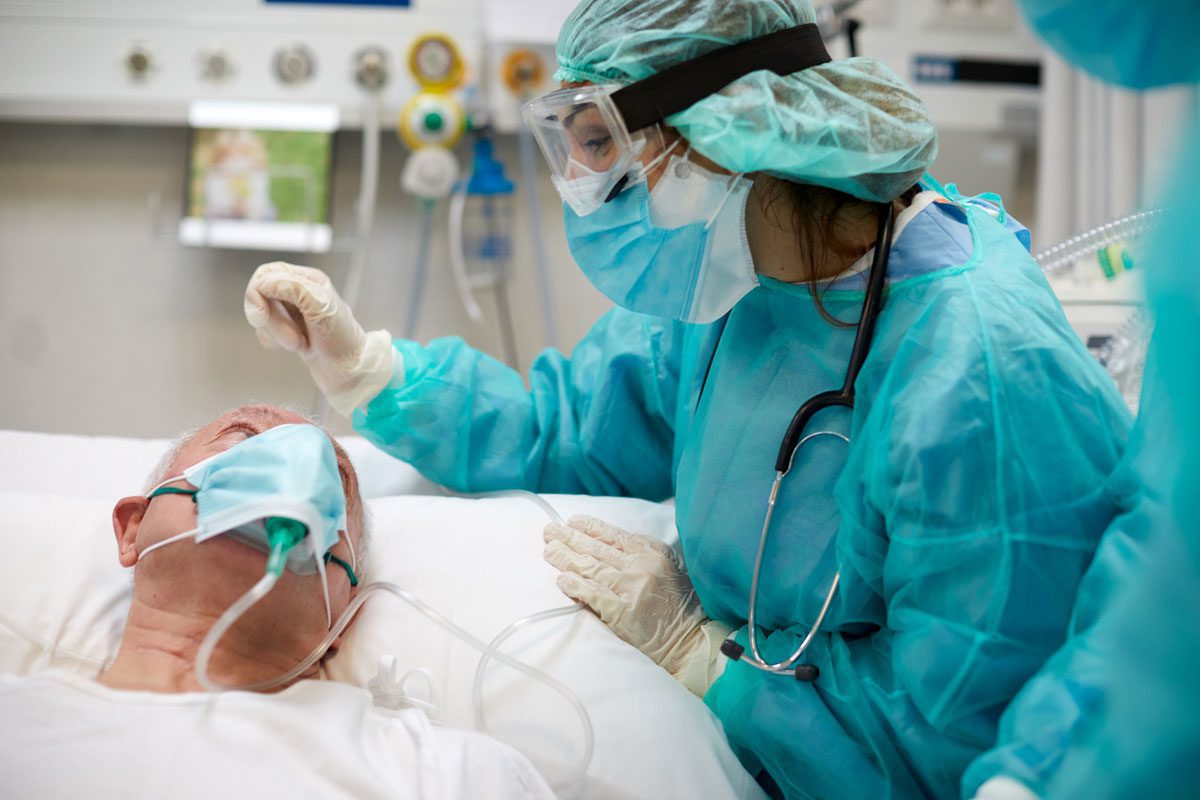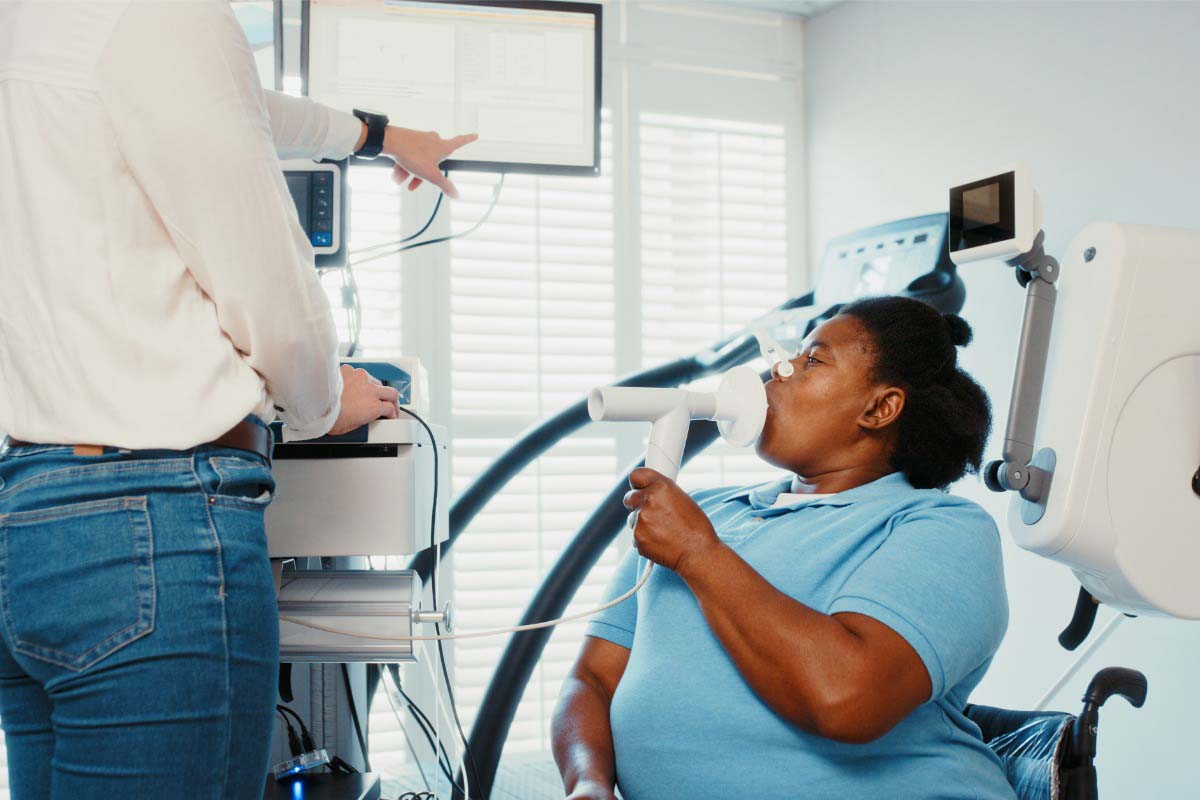ABSTRACT
Objective: To investigate the prevalence of obsessive-compulsive disorder (OCD) during the coronavirus disease 2019 (COVID-19) pandemic among the general population of the United Arab Emirates.
Methods: An online survey of a convenience sample was conducted between October 2020 and January 2021. The Yale-Brown Obsessive-Compulsive Scale (Y-BOCS) was used to assess symptoms of OCD. The rate of OCD symptoms in those who had positive COVID-19 test results was compared with those who had no previous COVID-19 diagnosis.
Results: The total number of participants was 702, including 371 males and 325 females (6 skipped the question regarding sex). Most participants reported no previous psychiatric history (84.3%). Previous psychiatric diagnoses were reported by 15.7% of participants (n = 110) and included generalized anxiety (27.3%), phobia (1.8%), depression (19.1%), bipolar mood disorder (1.8%), OCD (6.3%), and panic attacks (8.2%). There were 39 (5.6%) participants who had past psychiatric history but were unsure of the exact diagnosis. Presence of history of OCD for the total sample was reported by 7 (1%) participants. A family history of OCD was reported by 34 (4.8%) participants. A total of 218 (31.1%) participants scored mild, moderate, severe, or extreme OCD symptoms. Clinically significant OCD symptoms were reported by 75 participants (10.7% of the total sample). The mean (SD) score of the Y-BOCS was 6.63 (7.13) for the COVID-positive group and 4.9 (6.34) for the COVID-negative group, which was statistically significant (P = .0008).
Conclusions: The study findings indicate an increased prevalence of OCD during the COVID-19 pandemic, which is significantly higher among people with positive COVID-19 infection compared to those with negative COVID-19 test results.
Prim Care Companion CNS Disord 2022;24(2):21m03110
To cite: Hassani GA, Mufaddel AA. Obsessive-compulsive disorder during the COVID-19 pandemic: preliminary findings from a study in the United Arab Emirates. Prim Care Companion CNS Disord. 2022;24(2):21m03110.
To share: https://doi.org/10.4088/PCC.21m03110
© Copyright 2022 Physicians Postgraduate Press, Inc.
aAbu Dhabi Health Services Company–SEHA, Abu Dhabi, United Arab Emirates
bCzech Rehabilitation Hospital, Alain, United Arab Emirates
*Corresponding author: Amir A. Mufaddel, MD, Czech Rehabilitation Hospital, Alain UAE, Alain 1004, United Arab Emirates ([email protected]).
Current evidence for the association between coronavirus disease 2019 (COVID-19) and obsessive-compulsive disorder (OCD) is limited. However, the impact of the COVID-19 pandemic on people with OCD needs special attention, particularly for those with a history of obsessions related to contamination and washing rituals and compulsions. Increased shopping and use of soaps, sanitizers, and disinfectants may increase anxiety and worry in patients with OCD regarding possible lack of cleaning products.1
On the other hand, it has been suggested that the inevitability of a COVID infection can lead to decreasing rather than increasing OCD symptoms. This situation can also help to diminish stigma associated with the disorder and explain the nature of some OCD symptoms and behaviors that have been adaptive in periods of history, including the present pandemic, when no other effective means are available to combat infection.2
The objective of this study was to investigate the prevalence of OCD during the COVID-19 pandemic. Our focus on OCD is due to its nature of being a disabling condition characterized by distressing, intrusive thoughts that patients fail to resist. Compulsions or rituals may occur in OCD to compensate for the ego-dystonic feelings of the obsessive thoughts and can lead to a significant negative effect on the level of functioning.3
METHODS
This was a cross-sectional online survey of a convenience sample obtained between October 2020 and January 2021. The study was reviewed and approved by the Abu Dhabi Committee for COVID-19 Research.
Participants
Data were collected using a preexisting list of mobile numbers via which the link for the study was sent to participants. We used the database of SEHA (the corporate marketing name of Abu Dhabi Health Services Company) to identify the customer mobile phone numbers. Invitations were sent to 7,000 mobile numbers, and the response rate was 10.03%.
An online questionnaire was administered via SurveyMonkey software. The Yale-Brown Obsessive-Compulsive Scale (Y-BOCS)4 was used to assess symptoms of OCD. The questionnaire was administered to COVID-19–positive cases as well as those with no history of COVID-19 infection at the time of the study. The study groups were defined during statistical analysis.
Instruments
The Y-BOCS is a standardized rating scale that has both clinician-administered and self-report versions. The scoring for the severity scale consists of 10 items ranging from 0 (none) to 4 (extreme), giving the total Y-BOCS severity score that ranges from 0 to 40. The interrater reliability is excellent for total Y-BOCS scores; high internal consistency rates have been reported for the scale.5
The Arabic version was used to specifically measure the types and severity of symptoms of OCD. The scale is composed of 5 items on obsessions and 5 items on compulsions, with scores ranging from 0 to 4 (0 = no symptoms, 1 = mild, 2 = moderate, 3 = severe, and 4 = extreme). The maximum total score is 40. The total scores of the range of severity for obsessions and compulsions are as follows: 0–7 = subclinical (normal), 8–15 = mild, 16–23 = moderate, 24–31 = severe, and 32–40 = extreme. The cutoff score of clinically significant symptoms is 16.6 Participants were also asked to report the presence or absence of a history of OCD to identify new cases of obsessive-compulsive symptoms in both groups based on their current Y-BOCS scores.
Statistical Analysis
Social Science Statistics software was used for the statistical analysis. Missing sociodemographic data were reported in the descriptive statistics. There were no missing Y-BOCS data.
We performed descriptive statistics, t tests, and odds ratios (ORs). A P value ≤ .05 was considered statistically significant.
RESULTS
The total number of participants was 702, including 371 male and 325 female participants (6 skipped the question regarding sex in the online survey) (Table 1). There were 280 (39.9%) United Arab Emirates nationals and 419 (59.7%) participants of other nationalities (3 participants skipped the question).
Most participants reported no previous psychiatric history (84.3%). Previous psychiatric diagnoses were reported by 15.7% of participants (n = 110), with generalized anxiety being the most common diagnosis (27.3% of those who had a psychiatric history). The presence of a history of OCD for the total sample was reported by 7 (1%) participants. A family history of OCD was reported by 34 (4.8%) participants. Based on COVID-19 test results documented by participants, 334 (47.6%) had COVID-positive results and 367 (52.4%) had negative COVID results.
A total of 218 (31.1%) participants scored mild, moderate, severe, or extreme OCD symptoms, and 484 (68.9%) had subclinical symptoms (Table 2). With the cutoff point of 16 (moderate, severe, and extreme OCD symptoms), clinically significant OCD symptoms were reported by 75 participants, which represents 10.7% of the total sample.
The mean (SD) score of the Y-BOCS was 6.63 (7.13) for the COVID-positive group and 4.9 (6.34) for the COVID-negative group. Unpaired t test values were used in the calculation (t699 = 3.3701). The 2-tailed P value equaled .0008, which is extremely statistically significant by conventional criteria (Table 3).
We compared the severity scores in terms of OCD symptom severity (subclinical symptoms vs presence of OCD symptoms) between COVID-positive cases and those with no history of COVID-19 infection. COVID-positive subjects had significantly more symptoms of OCD than individuals with negative results (OR = 0.6301, P = .0049) (Table 4).
DISCUSSION
Our study indicates an increase in OCD prevalence during the COVID-19 pandemic. The prevalence of clinically significant symptoms of OCD during the pandemic, as indicated by Y-BOCS scores, is 11-fold greater than the previous history of OCD reported by the participants. However, the possibility of undiscovered cases before the pandemic should be considered. We found a statistically significant increase in OCD symptoms among COVID-positive participants compared to COVID-negative participants as indicated by Y-BOCS scores during the pandemic.
The prevalence of OCD in the general population is 3.1% according to different studies,2 and it leads to significant disability and negative impact on quality of life. Fear of contamination and washing rituals are a common set of compulsive symptoms in people with OCD, who may spend hours resisting worries and thoughts about the possibility of catching an infection and avoiding possible contaminants.2
Research suggests an increased prevalence of OCD symptoms during the COVID-19 pandemic that is significantly higher than that of the pre-pandemic period. For example, a study7 of OCD symptoms in young subjects with a primary diagnosis of OCD showed a significant increase in contamination obsessions and cleaning compulsions during the pandemic period. Specifically, the obsessions and compulsions subscales and total scores of the Children’s Y-BOCS were higher during than before the pandemic. This finding suggests that new symptoms may develop, and previously existing symptoms of OCD may worsen, during the COVID-19 pandemic.7
About one-third of patients with a history of OCD reported worsening of their previously existing symptoms when the COVID-19 pandemic started. Previous history of contamination-related OCD symptoms before the first lockdown was associated with increased severity of OCD symptoms.1
In a cross-sectional study8 that used an online survey, 60.3% of participants reported onset of OCD symptoms and 53.8% had washing compulsions during the COVID-19 pandemic. Those whose OCD symptoms began only since the start of the COVID-19 pandemic had significantly more moderate/high stress levels.8
The stages of the pandemic and measures taken and practiced by individuals may also have a role in the severity of OCD symptoms as suggested by a prospective cohort survey study9 among medical university students who completed 3 online surveys during 3 different periods: long quarantine period without classes in survey 1, online courses in survey 2, and when no new cases had been reported for 2 weeks in survey 3. Findings suggest an increase in Y-BOCS scores and anxiety symptoms during the quarantine period. The intensity of anxiety and fear was significantly lower during the periods of online courses and when no new cases were reported.9
Behaviors performed to prevent transmission of infection (eg, wearing of masks and physical distancing) are essential recommended measures for reducing COVID-19 transmission and contamination. However, that may also provoke obsessions and phobic anxiety in the community, particularly for vulnerable individuals. A US study10 found that COVID-19 behavior scores were significantly associated with contamination obsessions and phobias. The increased rate of contamination obsession, phobias, and cleaning compulsions complicates the diagnosis and treatment of psychiatric disorders during the current pandemic period.10
The present study has limitations that should be mentioned. First, the groups which were compared were identified during the analysis and are less well controlled. Another limitation is lack of long-term follow-up assessment, which restricts the ability to conclude whether the OCD symptoms are transient and confined to the pandemic period or whether COVID-19 was only a triggering factor for vulnerable people who have a prolonged history of OCD.
CONCLUSION
Our current study indicates an increased prevalence of OCD among the general population during the COVID-19 pandemic. People with positive COVID-19 test results are particularly at risk of developing OCD symptoms compared to those with negative results. Psychological assessment and screening for OCD symptoms should be considered essential for people with a positive history of COVID-19 infection.
Submitted: August 22, 2021; accepted December 9, 2021.
Published online: March 3, 2022.
Potential conflicts of interest: None.
Funding/support: None.
Clinical Points
- New emerging obsessive-compulsive disorder symptoms should be considered in the psychiatric assessment during periods of widespread infectious disease.
- A multidisciplinary approach for the management of positive cases during pandemics including psychological assessment and management can help minimize patient suffering.
References (10)

- Jelinek L, Moritz S, Miegel F, et al. Obsessive-compulsive disorder during COVID-19: turning a problem into an opportunity? J Anxiety Disord. 2021;77:102329. PubMed CrossRef
- Fontenelle LF, Miguel EC. The impact of coronavirus (COVID-19) in the diagnosis and treatment of obsessive-compulsive disorder. Depress Anxiety. 2020;37(6):510–511. PubMed CrossRef
- Brock H, Hany M. Obsessive-Compulsive Disorder. December 8, 2020. In: StatPearls [Internet]. Treasure Island, FL: StatPearls Publishing; 2021.
- Goodman WK, Price LH, Rasmussen SA, et al. The Yale-Brown Obsessive-Compulsive Scale: I. development, use, and reliability. Arch Gen Psychiatry. 1989;46(11):1006–1011. PubMed CrossRef
- Overduin MK, Furnham A. Assessing obsessive-compulsive disorder (OCD): a review of diagnostic interviews and clinician-rated instruments. Ann Psychiatry Ment Health. 2020;8(3):1152.
- Ahmed GK, Ramadan HKA, Refay SM, et al. Comparison of knowledge, attitude, socioeconomic burden, and mental health disorders of COVID-19 pandemic between general population and health care workers in Egypt. Egypt J Neurol Psychiat Neurosurg. 2021;57(1):25. PubMed CrossRef
- Tanir Y, Karayagmurlu A, Kaya İ, et al. Exacerbation of obsessive-compulsive disorder symptoms in children and adolescents during COVID-19 pandemic. Psychiatry Res. 2020;293:113363. PubMed CrossRef
- Abba-Aji A, Li D, Hrabok M, et al. COVID-19 pandemic and mental health: prevalence and correlates of new-onset obsessive-compulsive symptoms in a Canadian province. Int J Environ Res Public Health. 2020;17(19):6986. PubMed CrossRef
- Ji G, Wei W, Yue KC, et al. Effects of the COVID-19 pandemic on obsessive-compulsive symptoms among university students: prospective cohort survey study. J Med Internet Res. 2020;22(9):e21915. PubMed CrossRef
- Samuels J, Holingue C, Nestadt PS, et al. Contamination-related behaviors, obsessions, and compulsions during the COVID-19 pandemic in a United States population sample. J Psychiatr Res. 2021;138:155–162. PubMed CrossRef
Please sign in or purchase this PDF for $40.
